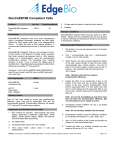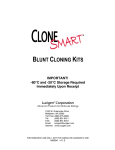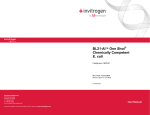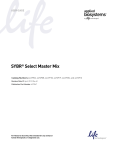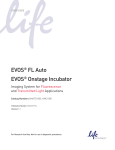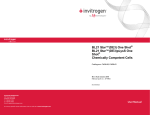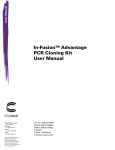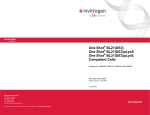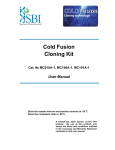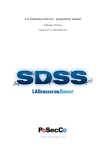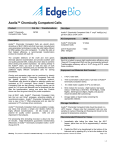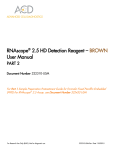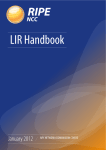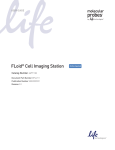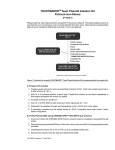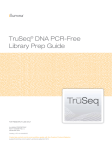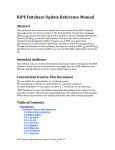Download One Shot TOP10 Competent Cells
Transcript
USER GUIDE One Shot® TOP10 Competent Cells Catalog Numbers C4040-10, C4040-03, C4040-06, C4040-50, and C4040-52 Document Part Number 280126 Publication Number MAN0000633 Revision A.0 For Research Use Only. Not for use in diagnostic procedures. Information in this document is subject to change without notice. DISCLAIMER LIFE TECHNOLOGIES CORPORATION AND/OR ITS AFFILIATE(S) DISCLAIM ALL WARRANTIES WITH RESPECT TO THIS DOCUMENT, EXPRESSED OR IMPLIED, INCLUDING BUT NOT LIMITED TO THOSE OF MERCHANTABILITY, FITNESS FOR A PARTICULAR PURPOSE, OR NON-INFRINGEMENT. TO THE EXTENT ALLOWED BY LAW, IN NO EVENT SHALL LIFE TECHNOLOGIES AND/OR ITS AFFILIATE(S) BE LIABLE, WHETHER IN CONTRACT, TORT, WARRANTY, OR UNDER ANY STATUTE OR ON ANY OTHER BASIS FOR SPECIAL, INCIDENTAL, INDIRECT, PUNITIVE, MULTIPLE OR CONSEQUENTIAL DAMAGES IN CONNECTION WITH OR ARISING FROM THIS DOCUMENT, INCLUDING BUT NOT LIMITED TO THE USE THEREOF. IMPORTANT LICENSING INFORMATION These products may be covered by one or more Limited Use Label Licenses. By use of these products, you accept the terms and conditions of all applicable Limited Use Label Licenses. TRADEMARKS The trademarks mentioned herein are the property of Life Technologies Corporation and/or its affiliate(s) or their respective owners. © 2013 Life Technologies Corporation. All rights reserved. 2 Contents About this guide .............................................................................................................. 4 Product information ........................................................................................................ 5 Contents ....................................................................................................................................................... 5 Description of the system............................................................................................................................ 6 Methods .......................................................................................................................... 7 Transform chemically competent cells ...................................................................................................... 7 Transform Electrocomp™ Cells ................................................................................................................... 9 Transformation control ............................................................................................................................. 10 Appendix A: Safety ........................................................................................................ 11 Documentation and Support ......................................................................................... 13 Obtaining support ...................................................................................................................................... 13 3 About this guide IMPORTANT! Changes from previous version Before using this product, read and understand the information in the “Safety” appendix in this document. Revision A.0 Date December 2013 Description • • 4 Replaced Product Qualification section with Obtaining Certificates of Analysis on page 13. Version numbering changed to alphanumeric format and reset to A in conformance with internal document control procedures Product information Contents Types of products This manual is supplied with the following products. Product Reactions Cat. no. 10 C4040-10 20 C4040-03 40 C4040-06 10 C4040-50 20 C4040-52 One Shot® TOP10 Chemically Competent E. coli One Shot® TOP10 Electrocomp™ E. coli Contents Each product contains the following components. Type of Cells Number of Tubes Volume Chemically Competent 11 (10 rxn), 21 (20 rxn), or 42 (40 rxn) 50 µL Electrocomp™ 11 (10 rxn), 21 (20 rxn) 50 µL All kits contain the following reagents: • 50 μL supercoiled pUC19 plasmid (10 pg/μL in 5 mM Tris-HCl, 5 mM EDTA, pH 8) for testing efficiency • S.O.C Medium (6 mL) for plating 5 Description of the system Genotype F- mcrA Δ(mrr-hsdRMS-mcrBC) φ80lacZΔM15 ΔlacX74 recA1 araD139 Δ(araleu)7697 galU galK rpsL (StrR) endA1 nupG General handling Be extremely gentle when working with competent cells. Competent cells are highly sensitive to changes in temperature or mechanical lysis caused by pipetting. Transformation should be started immediately following the thawing of the cells on ice. Mix by swirling or tapping the tube gently, not by pipetting. IMPORTANT! One Shot® TOP10 cells do not require IPTG to induce expression from the lac promoter. If blue/white screening is required to select for transformants spread 40 μL of 40 mg/mL X-Gal in dimethylformamide on top of the agar. Let the X-Gal diffuse into the agar for approximately 1 hour. 6 Methods Transform chemically competent cells Introduction This section provides two procedures to transform One Shot® TOP10 chemically competent E. coli. See Selecting a One Shot® chemical transformation procedure below to help you choose the best procedure to use for your needs. Selecting a One Shot® chemical transformation procedure Two procedures are provided to transform One Shot® TOP10 chemically competent E. coli. Consider the following factors when choosing which procedure to use. Note that if you use the rapid chemical transformation procedure, fewer transformants will be obtained. If you wish to… maximize the number of transformants obtained Then use the… regular Chemical transformation procedure (see page 8) use an antibiotic other than ampicillin to select for your plasmid (e.g. kanamycin) transform a plasmid containing a large insert (>1000 bp) obtain transformants as quickly as possible Rapid chemical transformation procedure (see page 8) IMPORTANT! The rapid chemical transformation procedure is only suitable for transformations using ampicillin selection. If you will be using any other antibiotic for selection (e.g. kanamycin), use the regular chemical transformation procedure. Materials needed • 37°C shaking and non-shaking incubator • 10-cm diameter LB agar plates with appropriate antibiotic • Ice bucket with ice • 42°C water bath • • • Equilibrate a water bath to 42°C. Warm the vial of S.O.C medium to room temperature. Spread X-Gal onto LB agar plates with antibiotic, if desired for blue/white selection. Warm the selective plates in a 37°C incubator for 30 minutes (use one plate for each transformation). Before starting • IMPORTANT! It is essential that LB plates containing 100 μg/mL ampicillin are pre-warmed if you are performing the rapid chemical transformation procedure. continued on next page 7 Transform chemically competent cells, continued Chemical transformation procedure The instructions provided below are for general use. Specific instructions for particular applications such as Zero Blunt® PCR Cloning are provided in the manual for that kit. 1. Centrifuge the vial(s) containing the ligation reaction(s) briefly and place on ice. 2. Thaw, on ice, one 50 μL vial of One Shot® cells for each ligation/transformation. 3. Pipet 1–5 μL of each ligation reaction directly into the vial of competent cells and mix by tapping gently. Do not mix by pipetting up and down. The remaining ligation mixture(s) can be stored at −20°C. 4. Incubate the vial(s) on ice for 30 minutes. 5. Incubate for exactly 30 seconds in the 42°C water bath. Do not mix or shake. 6. Remove vial(s) from the 42°C bath and place them on ice. 7. Add 250 μL of pre-warmed S.O.C medium to each vial. S.O.C is a rich medium; sterile technique must be practiced to avoid contamination. 8. Place the vial(s) in a microcentrifuge rack on its side and secure with tape to avoid loss of the vial(s). Shake the vial(s) at 37°C for exactly 1 hour at 225 rpm in a shaking incubator. 9. Spread 20–200 μL from each transformation vial on separate, labeled LB agar plates. The remaining transformation mix may be stored at 4°C and plated out the next day, if desired. 10. Invert the plate(s) and incubate at 37°C overnight. 11. Select colonies and analyze by plasmid isolation, PCR, or sequencing. Rapid chemical transformation procedure An alternative procedure is provided below for rapid transformation of One Shot® chemically competent E. coli. This procedure is only recommended for transformations using ampicillin selection. Note: It is essential that selective plates be pre-warmed prior to spreading. 1. Centrifuge the vial(s) containing the ligation reaction(s) briefly and place on ice. 2. Thaw, on ice, one 50 μL vial of One Shot® cells for each ligation/transformation. 3. Pipet 1–5 μL of each ligation reaction directly into the vial of competent cells and mix by tapping gently. Do not mix by pipetting up and down. The remaining ligation mixture(s) can be stored at −20°C. 4. Incubate the vial(s) on ice for 5 minutes. 5. Spread 50 μL of cells on a pre-warmed, labeled LB agar plate containing 100 μg/mL ampicillin and incubate at 37°C overnight. 6. Select colonies and analyze by plasmid isolation, PCR, or sequencing. 8 Transform Electrocomp™ Cells Materials needed • • • • • • Note One Shot® Electrocomp™ cells are supplied in 50 μL single-use aliquots. Please refer to the user manual included with your electroporator for cuvette size and reaction volume. You may dispose of any unused cells. Preparation For each transformation, you will need one vial of competent cells and at least one selective plate. • Thaw the vial of S.O.C medium and bring to room temperature. • Spread X-Gal onto LB agar plates with antibiotic, if desired. • Warm selective plates at 37°C for 30 minutes. • Place cuvettes on ice. • Thaw on ice 1 vial of One Shot® Electrocomp™ cells for each transformation. Electroporation procedure The instructions provided below are for general use. Specific instructions for particular applications such as TOPO® XL PCR Cloning are provided in the manual for that kit. 37°C shaking and non-shaking incubator 10-cm diameter LB agar plates with appropriate antibiotic Ice bucket with ice Electroporator Cuvettes (0.1- or 0.2-cm, see Note) 15-mL snap-cap tubes (one for each transformation) Note: For transformation of large plasmids, electroporation is preferred over chemical transformation because not only is the transformation efficiency higher, it is less biased against large recombinant plasmids. IMPORTANT! To avoid arcing, use only Electrocomp™ cells for electroporation. 1. Set up your electroporator for bacterial transformation. Follow the manufacturer's instructions. 2. Add 1–2 μL of each ligation reaction to the volume of cells recommended by the manufacturer (may be less than 50 μL). Mix gently with pipette tip. Do not mix by pipetting up and down. 3. Transfer the cells to the chilled electroporation cuvette on ice. 4. Electroporate the cells as per the manufacturer's recommended protocol. 5. Quickly add 250 μL room temperature S.O.C medium and mix gently. 6. Transfer the solution to a 15-mL snap-cap tube (i.e. Falcon) and shake for at least 1 hour at 37 °C to allow expression of the antibiotic resistance gene. 7. Spread 10–150 μL from each transformation on a prewarmed LB plate containing the appropriate antibiotic. The remaining transformation mix may be stored at 4°C and plated out the next day, if desired. 8. Incubate the plates overnight at 37°C. 9. Select colonies and analyze by plasmid isolation, PCR, or sequencing. 9 Transformation control Test the efficiency We recommend that you test the efficiency of the competent cells contained in the One Shot® Kit. This can be accomplished by using the supercoiled pUC19 plasmid supplied with the kit as described below. 1. Prepare LB agar plates containing 100 μg/mL ampicillin 2. Transform 1 μL (10 pg) into 50 μL of competent cells according to the transformation protocol appropriate for the type of cells. 3. Plate the control transformation as follows: Competent Cells pUC19 (pg) Volume to Plate Electrocomp™ 10 20 μL (1:10 dilution)* Chemically Competent 10 10 μL + 20 μL SOC *Just before plating the Electrocomp™ transformation mix, dilute 10 μL of the transformation mix with 90 μL of S.O.C medium. 4. Incubate overnight at 37°C and count colonies. Calculate transformation efficiency using the formula below. Calculation Calculate the transformation efficiency as transformants per 1 μg of plasmid DNA. For chemically competent cells, use the formula below to calculate transformation efficiency: 300 μL total # of colonies 106 pg transformation volume # transformants × × = 10 pg transformed DNA μg X μL plated μg plasmid DNA For Electrocomp™ cells, use the formula below to calculate transformation efficiency: Total # of colonies 106 pg transformation volume * # transformants × × × 10 = 10 pg transformed DNA μg X μL plated μg plasmid DNA *Volume dependent on the volume of cells used and the amount of S.O.C. added. Expected transformation efficiency: Cells 10 Transformation Efficiency Chemically competent >1 x 109 cfu/µg supercoiled plasmid Electrocomp™ >1 x 109 cfu/µg supercoiled plasmid Appendix A: Safety Chemical safety WARNING! GENERAL CHEMICAL HANDLING. To minimize hazards, ensure laboratory personnel read and practice the general safety guidelines for chemical usage, storage, and waste provided below, and consult the relevant SDS for specific precautions and instructions: • Read and understand the Safety Data Sheets (SDSs) provided by the chemical manufacturer before you store, handle, or work with any chemicals or hazardous materials. To obtain SDSs, see the “Documentation and Support” section in this document. • Minimize contact with chemicals. Wear appropriate personal protective equipment when handling chemicals (for example, safety glasses, gloves, or protective clothing). • Minimize the inhalation of chemicals. Do not leave chemical containers open. Use only with adequate ventilation (for example, fume hood). • Check regularly for chemical leaks or spills. If a leak or spill occurs, follow the manufacturer's cleanup procedures as recommended in the SDS. • Handle chemical wastes in a fume hood. • Ensure use of primary and secondary waste containers. (A primary waste container holds the immediate waste. A secondary container contains spills or leaks from the primary container. Both containers must be compatible with the waste material and meet federal, state, and local requirements for container storage.) • After emptying a waste container, seal it with the cap provided. • Characterize (by analysis if necessary) the waste generated by the particular applications, reagents, and substrates used in your laboratory. • Ensure that the waste is stored, transferred, transported, and disposed of according to all local, state/provincial, and/or national regulations. • IMPORTANT! Radioactive or biohazardous materials may require special handling, and disposal limitations may apply. 11 Biological hazard safety WARNING! BIOHAZARD. Biological samples such as tissues, body fluids, infectious agents, and blood of humans and other animals have the potential to transmit infectious diseases. Follow all applicable local, state/provincial, and/or national regulations. Wear appropriate protective equipment, which includes but is not limited to: protective eyewear, face shield, clothing/lab coat, and gloves. All work should be conducted in properly equipped facilities using the appropriate safety equipment (for example, physical containment devices). Individuals should be trained according to applicable regulatory and company/ institution requirements before working with potentially infectious materials. Read and follow the applicable guidelines and/or regulatory requirements in the following: In the U.S.: • U.S. Department of Health and Human Services guidelines published in Biosafety in Microbiological and Biomedical Laboratories found at: www.cdc.gov/biosafety • Occupational Safety and Health Standards, Bloodborne Pathogens (29 CFR§1910.1030), found at: www.access.gpo.gov/nara/cfr/waisidx_01/ 29cfr1910a_01.html • Your company’s/institution’s Biosafety Program protocols for working with/handling potentially infectious materials. • Additional information about biohazard guidelines is available at: www.cdc.gov In the EU: Check local guidelines and legislation on biohazard and biosafety precaution and refer to the best practices published in the World Health Organization (WHO) Laboratory Biosafety Manual, third edition, found at: www.who.int/ csr/resources/publications/biosafety/WHO_CDS_CSR_LYO_2004_11/en/ 12 Documentation and Support Obtaining support Obtaining Certificates of Analysis The Certificate of Analysis provides detailed quality control and product qualification information for each product. Certificates of Analysis are available on our website. Go to www.lifetechnologies.com/support and search for the Certificate of Analysis by product lot number, which is printed on the box. Obtaining SDSs Safety Data Sheets (SDSs) are available at www.lifetechnologies.com/sds. Limited Product Warranty Life Technologies Corporation and/or its affiliate(s) warrant their products as set forth in the Life Technologies’ General Terms and Conditions of Sale found on Life Technologies’ website at www.lifetechnologies.com/termsandconditions. If you have any questions, please contact Life Technologies at www.lifetechnologies.com/support. Technical Support For the latest services and support information for all locations, go to www.lifetechnologies.com. At the website, you can: • Access worldwide telephone and fax numbers to contact Technical Support and Sales facilities • Search through frequently asked questions (FAQs) • Submit a question directly to Technical Support ([email protected]) • Search for user documents, SDSs, vector maps and sequences, application notes, formulations, handbooks, certificates of analysis, citations, and other product support documents • Obtain information about customer training • Download software updates and patches 13 Notes 14 Headquarters 5791 Van Allen Way | Carlsbad, CA 92008 USA | Phone +1 760 603 7200 | Toll Free in USA 800 955 6288 For support visit lifetechnologies.com/support or email [email protected] lifetechnologies.com 4 December 2013
















